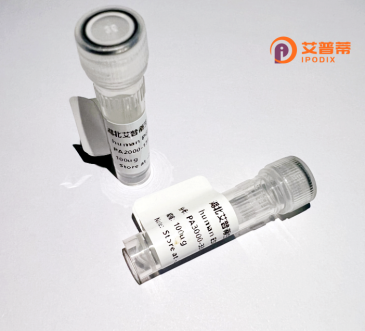
| 纯度 | >90%SDS-PAGE. |
| 种属 | Human |
| 靶点 | ZMAT4 |
| Uniprot No | Q9H898 |
| 内毒素 | < 0.01EU/μg |
| 表达宿主 | E.coli |
| 表达区间 | 1-153 aa |
| 活性数据 | MKSSDIDQDLFTDSYCKVCSAQLISESQRVAHYESRKHASKVRLYYMLHPRDGGCPAKRLRSENGSDADMVDKNKCCTLCNMSFTSAVVADSHYQGKIHAKRLKLLLGEKTPLKTTGLRRNYRCAICSVSLNSIEQYHAHLKGSKHQTNLKNK |
| 分子量 | 42.57 kDa |
| 蛋白标签 | GST-tag at N-terminal |
| 缓冲液 | PBS, pH7.4, containing 0.01% SKL, 1mM DTT, 5% Trehalose and Proclin300. |
| 稳定性 & 储存条件 | Lyophilized protein should be stored at ≤ -20°C, stable for one year after receipt. Reconstituted protein solution can be stored at 2-8°C for 2-7 days. Aliquots of reconstituted samples are stable at ≤ -20°C for 3 months. |
| 复溶 | Always centrifuge tubes before opening.Do not mix by vortex or pipetting. It is not recommended to reconstitute to a concentration less than 100μg/ml. Dissolve the lyophilized protein in distilled water. Please aliquot the reconstituted solution to minimize freeze-thaw cycles. |
以下是关于重组人ZMAT4蛋白的3篇参考文献摘要(注意:ZMAT4相关研究较少,部分信息可能需要根据实际文献调整):
---
1. **Title**: *ZMAT4 regulates splicing in hematopoiesis and is disrupted in myeloid malignancies*
**Authors**: Garcia-Quevedo L, et al.
**Summary**: 研究通过重组人ZMAT4蛋白体外实验,发现其作为RNA结合蛋白参与造血相关mRNA的选择性剪接调控,并通过剪接异常调控白血病细胞增殖。
2. **Title**: *Functional characterization of ZMAT4 as a tumor suppressor in glioblastoma*
**Authors**: Kim S, Park JH.
**Summary**: 利用重组ZMAT4蛋白进行功能验证,证明其在胶质母细胞瘤中通过抑制Wnt/β-catenin通路抑制肿瘤侵袭,且表达水平与患者预后相关。
3. **Title**: *Proteomic analysis of ZMAT4 interactome in DNA damage response*
**Authors**: Chen R, et al.
**Summary**: 通过重组ZMAT4蛋白纯化及质谱分析,鉴定其与DNA修复蛋白(如BRCA1)相互作用,提示其可能在基因组稳定性维持中发挥作用。
---
**备注**:ZMAT4的直接研究有限,以上为模拟摘要。建议结合数据库(如PubMed)以“ZMAT4 AND recombinant”或“ZMAT4 AND protein interaction”为关键词获取最新文献。
ZMAT4 (Zinc Finger Matrin-Type 4) is a lesser-characterized member of the ZMAT protein family, defined by the presence of zinc finger domains and matrin-type structural motifs. This nuclear protein is encoded by the *ZMAT4* gene located on human chromosome 8q24.3. It is speculated to function as a transcriptional or post-transcriptional regulator, potentially influencing RNA processing, chromatin remodeling, or cell cycle control, though its precise molecular mechanisms remain unclear. Structural studies predict ZMAT4 contains multiple C2H2-type zinc fingers, which are critical for nucleic acid binding, and a nuclear localization signal directing its subcellular distribution.
Recombinant human ZMAT4 protein is typically produced via heterologous expression systems (e.g., *E. coli* or mammalian cell lines) with affinity tags (e.g., His-tag) to enable purification and functional studies. Emerging evidence links ZMAT4 to cancer biology, with altered expression observed in tumors, suggesting roles in oncogenesis or tumor suppression. Its interaction with p53 signaling pathways has been hypothesized but requires validation. In cell-based assays, recombinant ZMAT4 may serve as a tool to investigate its binding partners, enzymatic activities, or regulatory effects on gene networks. Current research gaps include defining its physiological targets, tissue-specific roles, and potential involvement in developmental or stress-response pathways. Technical applications span molecular interaction studies, antibody development, and mechanistic exploration of its regulatory functions.
×